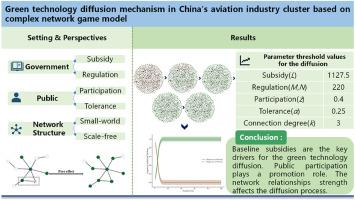基于复杂网络博弈模型的中国航空产业集群绿色技术扩散机制
IF 9
1区 工程技术
Q1 ENERGY & FUELS
引用次数: 0
摘要
航空产业集群中企业的多元化战略选择对绿色技术的推广产生了重要影响。为了研究外部因素和集群内部关联结构如何影响绿色技术的扩散,本文基于小世界网络,结合政府监管和公共监督的视角,构建了绿色技术网络的演化博弈模型。通过模拟现实世界的航空环境,我们分析了绿色技术扩散的动态特征。此外,我们还研究了政府和公共举措对促进航空制造企业绿色转型的推动作用。实证结果揭示了几个重要的启示:(1)政府规定的环境补贴最低门槛对推动绿色技术扩散至关重要。在环境监管处罚过低的情况下,企业会出现投机行为,阻碍技术推广进程。(2)扩大公众参与能显著提高绿色技术的推广速度,增加企业的平均收益。公众对环境污染的容忍阈值对绿色技术的成功推广具有高度敏感性。(3)我们发现了绿色技术在不同网络类型中传播的差异。虽然绿色技术成功地渗透到了不同密度的无标度网络中,但在密度较低的小世界网络中,绿色技术的传播却明显受阻。企业在集群中的关联结构和分层分布推动了绿色技术扩散的不同结果。本文章由计算机程序翻译,如有差异,请以英文原文为准。

Green technology diffusion mechanism in China's aviation industry cluster based on complex network game model
The aviation industry cluster's diverse strategic choices of firms significantly influence the green technology diffusion. To examine how external factors and intra-cluster associative structures influence green technology diffusion, this paper constructs an evolutionary game model of green technology networks based on small-world networks, integrating governmental regulation and public oversight perspectives. Through simulations within the real-world aviation context, we analyze the dynamic characteristics of green technology diffusion. Furthermore, we investigate the driving effects of governmental and public initiatives in facilitating green transformation of aviation manufacturing firms. The empirical results reveal several critical insights: (1) A government-mandated minimum threshold for environmental subsidies is crucial to propel the green technology diffusion. In scenarios where environmental regulation penalties are inadequately low, speculative behaviors among firms occur, hindering the diffusion process. (2) Amplifying public engagement significantly bolsters the rate of green technology diffusion and augments the average returns for firms. The public's tolerance threshold for environmental pollution exhibits a high sensitivity to the success of green technology diffusion. (3) We discern variances in green technology diffusion across different network types. While green technology successfully permeates scale-free networks with diverse densities, its diffusion is notably impeded in small-world networks with lower densities. The associative structures and hierarchical distribution of firms within clusters drive varying outcomes in green technology diffusion.
求助全文
通过发布文献求助,成功后即可免费获取论文全文。
去求助
来源期刊

Energy
工程技术-能源与燃料
CiteScore
15.30
自引率
14.40%
发文量
0
审稿时长
14.2 weeks
期刊介绍:
Energy is a multidisciplinary, international journal that publishes research and analysis in the field of energy engineering. Our aim is to become a leading peer-reviewed platform and a trusted source of information for energy-related topics.
The journal covers a range of areas including mechanical engineering, thermal sciences, and energy analysis. We are particularly interested in research on energy modelling, prediction, integrated energy systems, planning, and management.
Additionally, we welcome papers on energy conservation, efficiency, biomass and bioenergy, renewable energy, electricity supply and demand, energy storage, buildings, and economic and policy issues. These topics should align with our broader multidisciplinary focus.
 求助内容:
求助内容: 应助结果提醒方式:
应助结果提醒方式:


